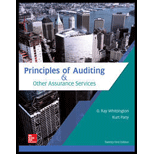
Principles Of Auditing & Other Assurance Services
21st Edition
ISBN: 9781259916984
Author: WHITTINGTON, Ray, Pany, Kurt
Publisher: Mcgraw-hill Education,
expand_more
expand_more
format_list_bulleted
Concept explainers
Question
Chapter 6, Problem 38AOQ
To determine
Identify a risk factor for misappropriation of assets out of the given options.
Expert Solution & Answer
Want to see the full answer?
Check out a sample textbook solution
Students have asked these similar questions
Financial accounting 12
Financial accounting 34.67.89
Please provide the solution to this general accounting question using proper accounting principles.
Chapter 6 Solutions
Principles Of Auditing & Other Assurance Services
Ch. 6 - Prob. 1RQCh. 6 - Prob. 2RQCh. 6 - Prob. 3RQCh. 6 - Discuss what is meant by the phrase shopping for...Ch. 6 - Prob. 5RQCh. 6 - Prob. 6RQCh. 6 - Prob. 7RQCh. 6 - Prob. 8RQCh. 6 - Prob. 9RQCh. 6 - Prob. 10RQ
Ch. 6 - Prob. 11RQCh. 6 - Prob. 12RQCh. 6 - Prob. 13RQCh. 6 - Prob. 14RQCh. 6 - Prob. 15RQCh. 6 - What is meant by making a proper year-end cutoff?...Ch. 6 - Prob. 17RQCh. 6 - Prob. 18RQCh. 6 - Prob. 19RQCh. 6 - Prob. 20RQCh. 6 - Auditing standards require the auditors to have a...Ch. 6 - Prob. 22RQCh. 6 - Prob. 23RQCh. 6 - Prob. 24QRACh. 6 - Prob. 25QRACh. 6 - Prob. 26QRACh. 6 - Prob. 27QRACh. 6 - Prob. 28QRACh. 6 - Prob. 29QRACh. 6 - Prob. 30QRACh. 6 - Prob. 31QRACh. 6 - Prob. 32QRACh. 6 - Prob. 33QRACh. 6 - Prob. 34QRACh. 6 - Prob. 35QRACh. 6 - Prob. 36QRACh. 6 - Prob. 37QRACh. 6 - Prob. 38AOQCh. 6 - Prob. 38BOQCh. 6 - Prob. 38COQCh. 6 - Prob. 38DOQCh. 6 - Prob. 38EOQCh. 6 - Prob. 38FOQCh. 6 - Prob. 38GOQCh. 6 - Prob. 38HOQCh. 6 - Prob. 38IOQCh. 6 - Prob. 38JOQCh. 6 - Prob. 38KOQCh. 6 - Prob. 38LOQCh. 6 - Prob. 39OQCh. 6 - Prob. 40OQCh. 6 - Prob. 41OQCh. 6 - Prob. 42AOQCh. 6 - Prob. 42BOQCh. 6 - Prob. 42COQCh. 6 - Tracing from source documents to journals most...Ch. 6 - Vouching from journals (or ledgers) to source...Ch. 6 - For each definition (or portion of a definition)...Ch. 6 - Prob. 44PCh. 6 - Prob. 45PCh. 6 - Tammy Potter, a new partner with the regional CPA...
Knowledge Booster
Learn more about
Need a deep-dive on the concept behind this application? Look no further. Learn more about this topic, accounting and related others by exploring similar questions and additional content below.Similar questions
- Harlow Co. is a merchandising company. Last month the company's cost of goods sold was $65,200. The company's beginning merchandise inventory was $12,500 and its ending merchandise inventory was $22,400. What was the total amount of the company's merchandise purchases for the month? Helparrow_forwardWhat is the amount of total assets?arrow_forwardProvide Accurate Answerarrow_forward
- Flare Enterprises sells a product in a competitive marketplace. Market analysis indicates that its product would probably sell at $60 per unit. Flare management desires a 15% profit margin on sales. Their current full cost for the product is $52 per unit. In order to meet the new target cost, how much will the company have to cut costs per unit, if any? HELParrow_forwardWendell Transport purchased a new delivery van for $75,000. The van is expected to have a salvage value of $9,000 after 6 years or 120,000 kilometers of use. During the first and second years of operation, Wendell Transport drove the van 30,000 kilometers and 15,000 kilometers, respectively. What is the depreciation expense for the second year using the units-of-activity method? A. $8,250 B. $6,000 C. $7,500 D. $9,000 helparrow_forward5 PTSarrow_forward
- Direct materials: 22300, direct labor: 27800arrow_forwardFlare Enterprises sells a product in a competitive marketplace. Market analysis indicates that its product would probably sell at $60 per unit. Flare management desires a 15% profit margin on sales. Their current full cost for the product is $52 per unit. In order to meet the new target cost, how much will the company have to cut costs per unit, if any?arrow_forwardAt the beginning of the year, Ironclad Corp. had total assets of $920,000 and total liabilities of $610,000. During the year, total liabilities increased by $90,000 and stockholders' equity decreased by $45,000. What is the amount of total assets at the end of the year?arrow_forward
arrow_back_ios
SEE MORE QUESTIONS
arrow_forward_ios
Recommended textbooks for you
 Auditing: A Risk Based-Approach (MindTap Course L...AccountingISBN:9781337619455Author:Karla M Johnstone, Audrey A. Gramling, Larry E. RittenbergPublisher:Cengage Learning
Auditing: A Risk Based-Approach (MindTap Course L...AccountingISBN:9781337619455Author:Karla M Johnstone, Audrey A. Gramling, Larry E. RittenbergPublisher:Cengage Learning Auditing: A Risk Based-Approach to Conducting a Q...AccountingISBN:9781305080577Author:Karla M Johnstone, Audrey A. Gramling, Larry E. RittenbergPublisher:South-Western College Pub
Auditing: A Risk Based-Approach to Conducting a Q...AccountingISBN:9781305080577Author:Karla M Johnstone, Audrey A. Gramling, Larry E. RittenbergPublisher:South-Western College Pub- Business/Professional Ethics Directors/Executives...AccountingISBN:9781337485913Author:BROOKSPublisher:CengagePrinciples of Accounting Volume 1AccountingISBN:9781947172685Author:OpenStaxPublisher:OpenStax College

Auditing: A Risk Based-Approach (MindTap Course L...
Accounting
ISBN:9781337619455
Author:Karla M Johnstone, Audrey A. Gramling, Larry E. Rittenberg
Publisher:Cengage Learning

Auditing: A Risk Based-Approach to Conducting a Q...
Accounting
ISBN:9781305080577
Author:Karla M Johnstone, Audrey A. Gramling, Larry E. Rittenberg
Publisher:South-Western College Pub


Business/Professional Ethics Directors/Executives...
Accounting
ISBN:9781337485913
Author:BROOKS
Publisher:Cengage

Principles of Accounting Volume 1
Accounting
ISBN:9781947172685
Author:OpenStax
Publisher:OpenStax College